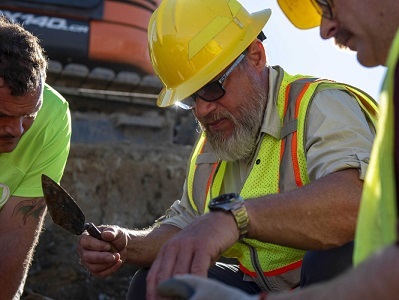
David Brown conducts recovery operations during a mission in northern Germany, Sept. 6, 2023. Agency personnel conducted an excavation in an effort to find a U.S. aircraft crew lost over Germany during World War II. Credit: U.S. Marine Corps photo by Sgt. Jack A. E. Rigsby
David Brown has wanted to be an archaeologist since he was eight years old, growing up in Hoffman Estates, Illinois, just outside of Chicago. He said he loved the idea of uncovering ancient artifacts and bringing history back to life.
But Brown first had a different mission to fulfill — service to his country.
Brown enlisted in the Army for a two-year tour in 1987, operating the Multiple Launch Rocket System and other systems within the field artillery branch.
"The Army helped me become a more responsible person," he said. "Also, I became more patriotic, having a better understanding of how the military protects the nation and the dedicated people who do it."
After his enlistment, Brown used his GI Bill benefits to get a graduate degree in archaeology.
He got a job with the U.S. Forest Service in New Mexico, identifying for firefighters important cultural and archaeological sites that needed protection from oncoming wildfires. They would bulldoze a firebreak area around the site to prevent the fire from spreading, he explained.
Later, he became branch chief archaeologist in Hawaii for the Hawaii State Historic Preservation Division.
Eight years ago, Brown accepted an offer from the Defense POW/MIA Accounting Agency to be a laboratory forensic archaeologist and scientific recovery expert.
The agency, which is part of the Defense Department, searches in 45 countries for missing service members from World War II and later conflicts, including the Korean War, Vietnam War and Desert Storm.
Once remains are recovered and the agency's laboratory determines the person's identity through DNA analysis and other means of identification, then the service member's family is notified and arrangements are made for a military funeral.
Brown's work has taken him to remote areas, including Papua New Guinea, Laos, Cambodia and Vietnam.
Currently, he's on his second mission in Germany, this time in the northeast part.
He's part of a 25-person team seeking to recover remains of the 10 airmen flying in a B-24H Liberator bomber that was presumably shot down by the enemy while returning from a bombing run.
The team is still in the early stage of the mission, recovering parts of the aircraft and the airmen's personal effects, among other items.
Although the site is not remote or rugged, the challenge for the recovery team is digging a deep excavation pit, as the steep angle of the aircraft's impact resulted in it being buried far below the surface of a farmer's field. Also, parts of the aircraft were severely distorted by melting that resulted from the fiery crash, he said.
Heavy equipment is being used for the dig and a lot of safety protocols are in place to prevent soil destabilization and hazards to the workers and their equipment, he said.
"This particular excavation took several months of planning," he said.
Brown is the only civilian on the team. The 24 others are from different branches of the military and from different jobs. Brown oversees all the archaeological work.
Every recovery site is different, and every team is different, he said. "Even though I have a degree and experience in a variety of archaeology projects, I learn something new every day — both from the site itself, as well as from each of the team members. The diverse experiences of the team definitely contributes to the success of the mission."
Brown said he tries hard not to let his emotions interfere in the work he's doing.
"I want to stay objective as best I can. Too much emotion, such as thinking of the loss of the service members and the grief their families must have experienced, could cloud my judgment. So, I try to keep some separation," he said.
Brown admitted that there were some occasions that he had to stop work for a minute to collect himself. He said he and the team have a full grasp of the important work they are doing — bringing missing service members home.
Republished courtesy of U.S. Army.